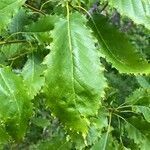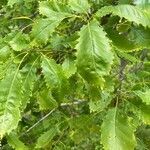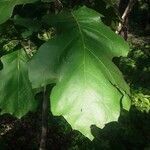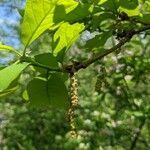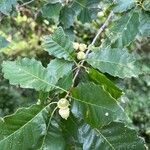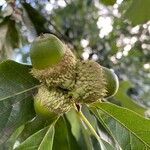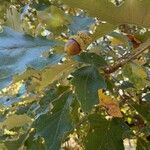Trees , deciduous, to 30 m. Bark dark gray, scaly or flat-ridged. Twigs light brown or tan, 2-3(-4) mm diam., glabrous. Buds light or dark brown, globose to ovoid, 2-3 mm, glabrous. Leaves: petiole (4-)10-25(-30) mm. Leaf blade obovate to narrowly elliptic or narrowly obovate, (79-)120-180(-215) × (40-)70-110(-160) mm, base narrowly cuneate to acute, margins regularly toothed, or entire with teeth in distal 1/2 only, or moderately to deeply lobed, or sometimes lobed proximally and toothed distally, secondary veins arched, divergent, (3-)5-7 on each side, apex broadly rounded or ovate; surfaces abaxially light green or whitish, with minute, flat, appressed-stellate hairs and erect, 1-4-rayed hairs, velvety to touch, adaxially dark green, glossy, glabrous. Acorns 1-3(-5) mm, on thin axillary peduncle (20-)40-70 mm; cup hemispheric or turbinate, 10-15 mm deep × 15-25 mm wide, enclosing 1/2-3/4 nut, scales closely appressed, finely grayish tomentose, those near rim of cup often with short, stout, irregularly recurved and sometimes branched, spinose awns emerging from tubercle; nut light brown, ovoid-ellipsoid or oblong, (12-)15-21(-25) × 9-18 mm, glabrous. Cotyledons distinct. 2 n = 24.
More
Tree to 30 m, with thick, dark, furrowed and flat-ridged bark; lvs obovate, cuneate to a rounded or acute base, with 6–10 pairs of coarse, irregular, rounded teeth, pale or whitened beneath with pubescence of both short, horizontally spreading and erect, few-branched stellate hairs, rather velvety to the touch; winter-buds glabrous or nearly so; peduncles (2–)4–7 cm, usually with 2 acorns; cup hemispheric, covering about half the nut, the lower scales strongly convex on the back, the upper scales long-acuminate or even caudate; nut broadly ovoid, 1.5–2.5 cm. Flood-plains and other poorly drained sites; Que. and Me. to s. Mich. and c. Minn., s. to N.C., Tenn., and n. Ark.
A medium sized tree. It grows to 22 m high. The trunk can be 90 cm across. The trunk is short and forked. The crown is open and rounded. The leaves are 12-17 cm long. They are widest above the middle. They taper to a wedge shaped base. Each vein ends in a shallow rounded lobe. The leaves are shiny dark green on the upper surface and pale greyish-green underneath. There are many white hairs. The acorns are 20-30 mm long. They occur either singly or in pairs. The acorn stalks are 2-10 cm long. The tips of the scales of the cup curve backwards. The cup encloses about one third of the nut. The cup usually has a fringe along the edge.
Found in a variety of soils in swamp forests of river bottoms, stream-sides, depressions, borders of ponds, lakes, and swamps and moist peaty flats; sometimes on moist slopes and poorly drained uplands; at elevations up to 1,000 metress.
More
It is a temperate plant. It grows in moist flat land and along the edges of swamps. It can tolerate some shade. In Melbourne Botanical Gardens. It suits hardiness zones 4-10. Arboretum Tasmania.
